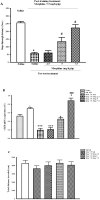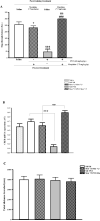Pentylenetetrazol and Morphine Interaction in a State-dependent Memory Model: Role of CREB Signaling
- PMID: 33613894
- PMCID: PMC7878041
- DOI: 10.32598/bcn.11.4.1482.1
Pentylenetetrazol and Morphine Interaction in a State-dependent Memory Model: Role of CREB Signaling
Abstract
Introduction: State-dependent (STD) memory is a process, in which the learned information can be optimally retrieved only when the subject is in the state similar to the encoding phase. This phenomenon has been widely studied with morphine. Several studies have reported that Pentylenetetrazole (PTZ) impairs memory in experimental animal models. Due to certain mechanistic interactions between morphine and PTZ, it is hypothesized that PTZ may interfere with the morphine-STD. The cyclic adenosine monophosphate Response Element-Binding (CREB) is considered as the main downstream marker for long-term memory. This study was designed to determine the possible interaction between PTZ and morphine STD and the presumable changes in CREB mRNA.
Methods: In an Inhibitory Avoidance (IA) model, posttraining morphine (2.5, 5, and 7.5 mg/ kg-i.p.) was used. The pre-test morphine was evaluated for morphine-induced STD memory. Moreover, the effect of a pre-test PTZ (60 mg/kg-i.p.) was studied along with morphine STD. Locomotion testing was carried out using open-field. Eventually, using real-time-PCR, the CREB mRNA changes in the hippocampus were evaluated.
Results: Posttraining MOR (7.5 mg/kg-i.p.) impaired IA memory (P<0.001). The pre-test injection of similar doses of morphine recovered the morphine-induced memory impairment (P<0.001). The pre-test PTZ impaired the IA memory recall (P<0.001); however, the pre-test PTZ along with morphine STD potentiated the morphine-induced STD (P<0.001). Alterations in CREB mRNA were observed in all groups. No difference was seen in the locomotor activity.
Conclusion: Presumably, the certain interactive effect of PTZ on morphine-induced STD is mediated through gamma-aminobutyric acid and opioid systems via CREB signaling.
Keywords: CREB; Inhibitory avoidance memory; Morphine; PTZ; State-dependent memory.
Copyright© 2020 Iranian Neuroscience Society.
Conflict of interest statement
Conflict of interest The authors declared no conflict of interest.
Figures



Similar articles
-
MiR-33-5p Regulates CREB to Induce Morphine State-dependent Memory in Rats: Interaction with the µ Opioid Receptor.Int J Mol Cell Med. 2022;11(2):150-167. doi: 10.22088/IJMCM.BUMS.11.2.150. Epub 2023 Feb 1. Int J Mol Cell Med. 2022. PMID: 37091037 Free PMC article.
-
Protection against Morphine-Induced Inhibitory Avoidance Memory Impairment in Rat by Curcumin: Possible Role of Nitric Oxide/ cAMP-Response Element Binding Protein Pathway.Iran J Med Sci. 2022 Nov;47(6):594-602. doi: 10.30476/IJMS.2022.92131.2339. Iran J Med Sci. 2022. PMID: 36380970 Free PMC article.
-
Role of hippocampal and prefrontal cortical signaling pathways in dextromethorphan effect on morphine-induced memory impairment in rats.Neurobiol Learn Mem. 2016 Feb;128:23-32. doi: 10.1016/j.nlm.2015.11.015. Epub 2015 Dec 18. Neurobiol Learn Mem. 2016. PMID: 26708494
-
[Impaired memory following repeated pentylenetetrazol treatments in kindled mice].Yakugaku Zasshi. 2012;132(2):179-82. doi: 10.1248/yakushi.132.179. Yakugaku Zasshi. 2012. PMID: 22293696 Review. Japanese.
-
Neuropathological profile of the pentylenetetrazol (PTZ) kindling model.Int J Neurosci. 2018 Nov;128(11):1086-1096. doi: 10.1080/00207454.2018.1481064. Epub 2018 Jun 7. Int J Neurosci. 2018. PMID: 29792126 Review.
Cited by
-
Therapeutic implications of phosphorylation- and dephosphorylation-dependent factors of cAMP-response element-binding protein (CREB) in neurodegeneration.Pharmacol Rep. 2023 Oct;75(5):1152-1165. doi: 10.1007/s43440-023-00526-9. Epub 2023 Sep 9. Pharmacol Rep. 2023. PMID: 37688751 Review.
-
Transcutaneous Auricular Vagus Nerve Stimulation Restores Cognitive Impairment in Morphine-Withdrawn Rats: Role of BDNF and Glial Cells in the Hippocampus.Addict Biol. 2025 Apr;30(4):e70016. doi: 10.1111/adb.70016. Addict Biol. 2025. PMID: 40183201 Free PMC article.
-
MiR-33-5p Regulates CREB to Induce Morphine State-dependent Memory in Rats: Interaction with the µ Opioid Receptor.Int J Mol Cell Med. 2022;11(2):150-167. doi: 10.22088/IJMCM.BUMS.11.2.150. Epub 2023 Feb 1. Int J Mol Cell Med. 2022. PMID: 37091037 Free PMC article.
-
Investigating the Co-administration of Ghrelin and Nicotine Into the Medial Septum and Its Influencing on Morphine Amnestic Effect.Basic Clin Neurosci. 2023 May-Jun;14(3):365-374. doi: 10.32598/bcn.2022.3667.1. Epub 2023 May 1. Basic Clin Neurosci. 2023. PMID: 38077176 Free PMC article.
-
Protection against Morphine-Induced Inhibitory Avoidance Memory Impairment in Rat by Curcumin: Possible Role of Nitric Oxide/ cAMP-Response Element Binding Protein Pathway.Iran J Med Sci. 2022 Nov;47(6):594-602. doi: 10.30476/IJMS.2022.92131.2339. Iran J Med Sci. 2022. PMID: 36380970 Free PMC article.
References
-
- Aniol V., Ivanova-Dyatlova A. Y., Tishkina A., Fominykh V., Kvichanskii A., Gulyaeva N. (2015). A single episode of seizures induced by pentylenetetrazole is followed by a cognitive decline. Opera Medica et Physiologica, 1(1), S1 https://cyberleninka.ru/article/n/
-
- Aniol V. A., Ivanova-Dyatlova A. Y., Keren O., Guekht A. B., Sarne Y., Gulyaeva N. V. (2013). A single pentylenetetrazole-induced clonic-tonic seizure episode is accompanied by a slowly developing cognitive decline in rats. Epilepsy & Behavior, 26(2), 196–202. [DOI:10.1016/j.yebeh.2012.12.006] [PMID ] - DOI - PubMed
-
- Assaf F., Fishbein M., Gafni M., Keren O., Sarne Y. (2011). Pre-and post-conditioning treatment with an ultra-low dose of Δ9-Tetrahydrocannabinol (THC) protects against Pentylenetetrazole (PTZ)-induced cognitive damage. Behavioural Brain Research, 220(1), 194–201. [DOI:10.1016/j.bbr.2011.02.005] [PMID ] - DOI - PubMed
-
- Baratti C., De Erausquin G., Faiman C. (1990). Brain opioid peptides may participate in the reversal of pentylenetetrazol-induced amnesia. Methods and Findings in Experimental and Clinical Pharmacology, 12(7), 451–6. [PMID ] - PubMed
LinkOut - more resources
Full Text Sources
Research Materials
